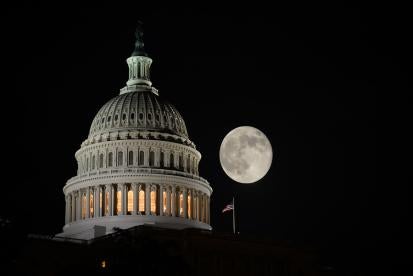With President Trump in the White House and Republicans in control of the House and the Senate, renewed attention is being given to the Congressional Review Act (CRA) as a tool to roll back a broad range of Obama Administration regulations. This legislative mechanism has been rarely used, but will provide an opportunity for a new, unified Republican government to wipe some of the slate clean.
This week, House Republicans will begin the process of seeking to eliminate some of the so-called “midnight” rules adopted in the final two months of the Obama Administration. According to the schedule released by Majority Leader Kevin McCarthy, the House intends to consider five House Joint Resolutions to disapprove, among other rules, the “Stream Protection Rule” issued by the Department of the Interior, the final “Publish What You Pay” rule promulgated by the Securities and Exchange Commission, and a Bureau of Land Management rule relating to “Waste Prevention, Production Subject to Royalties, and Resource Conservation.”
Given restraints built into Act and the large number of rules potentially up for consideration, we are skeptical that the CRA will turn out to be as useful as many Republicans had hoped. As further discussed below, opponents of various Obama Administration rules may soon see that the CRA is a powerful tool on paper but it is no panacea in practice.
Historical Context and the Narrow Window of Relevance
The CRA emerged from a long history of attempts by Congress to garner greater control over administrative regulation. Broadly stated, the aim of the CRA is to give Congress more control over the administrative state by providing for expedited legislative review of newly promulgated rules. Under the CRA, when an executive agency issues a new regulation, Congress may, by joint resolution, disapprove of it. With the President’s signature, the joint resolution invalidates and thus prevents the regulation from taking effect.
Since the New Deal, Congress has found itself unable to handle, by specific legislation, the many regulations required by a complex, modern economy. It has tended to delegate, therefore, broad swaths of authority to executive agencies. At the same time, Congress has worried that such broad delegations may leave too much power in the hands of an ever-growing bureaucracy, whose rules may not suit the needs of industry or the preferences of various constituencies. For a time, Congress sought to fix this problem with the legislative veto, whereby each or both houses reserved the ability to negate rules emerging from executive agencies. But in 1983 the Supreme Court ruled the legislative veto unconstitutional, stating that Congress could not invalidate the actions of agencies all on its own.
Seeking a replacement, and thus some form of control, Congress passed the Congressional Review Act in 1996, as a part of the Small Business Regulatory Enforcement Fairness Act. The CRA review process is, in some ways, like the legislative veto. It allows Congress, through a joint resolution brought to the floor in expedited fashion, to disapprove of new rules promulgated by executive agencies. The catch, however, is that such a joint resolution must also be signed by the President before the rule is invalidated.
Because Presidents are not usually enthusiastic about invalidating the rules of their own Administration, the CRA has largely been left unused by Congress. However, the CRA finds renewed possibilities during transitions underway now – namely, when a new party seizes control of the Presidency, while also controlling both Houses of Congress. For one, outgoing presidents typically seek to pass midnight regulations as their administrations wind down, and in anticipation of a change in control. The Obama Administration has proven no exception. And incoming presidents, at least when hailing from the opposing party, will typically be interested in reversing many of those new regulations. President-Elect Donald Trump has been clear about his desire to reverse a variety of Obama Administration actions, some of which can be addressed through an Executive Order, but others of which will undoubtedly be addressed by the 115th Congress.
The Procedure
Under the CRA, before any new rule may take effect, the issuing agency must submit it to Congress. “Major rules” – those with an annual cost of $100 million or more to the economy, a major effect on prices, or other significant adverse effects – may not take effect for at least sixty days. During that time, Congress may enact, by simple majority vote in each house, a joint resolution of disapproval. When signed by the President, the rule is nullified. Note that a complex scheme of measuring time until a rule takes effect – whether counting by legislative days, calendar days, or otherwise – assures that even adjournments and breaks, as well as misaligned House and Senate calendars, will not prevent either the House or Senate from having ample time to review new rules. When a major rule is submitted in the final sixty days of a congressional session, for instance, there is a special extended review period. As a result, a disapproval resolution may still issue within seventy five legislative days of when the next session of Congress convenes.
The CRA provides an expedited legislative path for these resolutions of disapproval. In the Senate, a submitted new rule is referred to the relevant committee, which has twenty days to report on a disapproval resolution. If it does not, such a resolution can, nevertheless, be brought to the floor upon a petition signed by thirty Senators. Once a disapproval resolution reaches the floor, the CRA precludes the use of the filibuster, sets time limits for debate (up to ten hours), and eliminates other procedural hurdles. (Ten hours of debate may not seem like much time to debate an issue, but in the Senate it can seem like a lifetime—that will be especially true in the next few months as the Senate seeks to repeal and replace Obamacare and it considers President Trump’s nomination to fill the current Supreme Court vacancy.) The House, for its part, considers the submitted rule under its general procedures. And crucially, when a disapproval resolution is sent from either the House to the Senate, or the Senate to the House, the chamber in receipt may not refer the resolution to a committee, but must bring the matter to the floor in the form approved by the other body.
Finally, disapproval resolutions may only be enacted as individual, stand-alone measures, using a template that is outlined in the Act itself. This ensures that unrelated bills are not combined with disapproval resolutions in order to exploit the expedited procedures under the CRA. It also assures that there are no discrepancies between the House and Senate versions of disapproval resolutions, and thus bypassing the need for a conference report and allowing the joint resolution to move swiftly to the President’s desk.
In an effort to address these limitations, the House on January 4 approved the “Midnight Rules Relief Act of 2017,” which would amend the CRA to provide for en bloc consideration in resolutions of disapproval of multiple rules at once. Given that Senate Democrats are likely to block consideration of the legislation, the one-rule-at-a-time disapproval resolution will likely be in effect during the 115th Congress.
Once a joint disapproval resolution is passed by both Houses and signed by the President, the new rule is effectively nullified. It may not be “reissued in the same form,” and further, any new variation that is “substantially the same” as the previously rejected rule is prohibited as well, barring express statutory authorization enacted subsequent to the disapproval resolution. In the event that Congress has rejected a rule that an agency is otherwise required to issue, the agency is given an automatic one year extension to attempt to fashion something different to meet the requirement.
The CRA is About to Get its First Real Test in a Long Time
The Congressional Review Act has not been used frequently in the past. In fact, only one rule – relating to ergonomics standards – has ever been rejected with this process. That occurred in 2001, when President George W. Bush agreed with Congress to reject the ergonomics rule adopted by OSHA in the waning days of the Clinton Administration.
That the CRA has been used so infrequently is not surprising. As mentioned above, it is a promising mechanism in the unique situation of a transfer of the presidency from one party to the other, which also controls Congress. In 2015, the Republican Congress sought to use the CRA to block President Obama’s Clean Power Plan, but of course he vetoed the measure when it reached his desk. Further, the stand-alone requirement in the Senate means that each disapproval resolution will likely consume the entire permitted time for debate, using up a valuable share of limited available floor time. As noted above, with the Senate likely to be bogged down with Obamacare repeal and replace legislation, as well as a Supreme Court nomination, and potentially other measures, finding 10 hours will likely prove to be a real challenge for the Senate Republican leadership. Finally, there may be alternative legislative methods to eliminate several regulations at once, such as through the appropriations process and a denial of funding.
As should become apparent this week, the House can easily move disapproval resolutions. The challenge will be, as always, getting anything through the Senate, even with expedited procedures in place to move things along. Given the limitations built into the CRA and the challenge of getting ten hours of Senate floor time for each disapproval resolution, Republicans in Congress will likely need to prioritize their use of the CRA, while looking for other mechanisms (such as reconciliation) to advance their policy objectives. In the end, without reform to the CRA, the 115th Congress will be challenged to move more than a handful of resolutions to the President’s desk for his signature. In short, they’ve got a powerful tool to use, but it is no panacea.
Jeffrey Long is co-author of this article.




 />i
/>i
